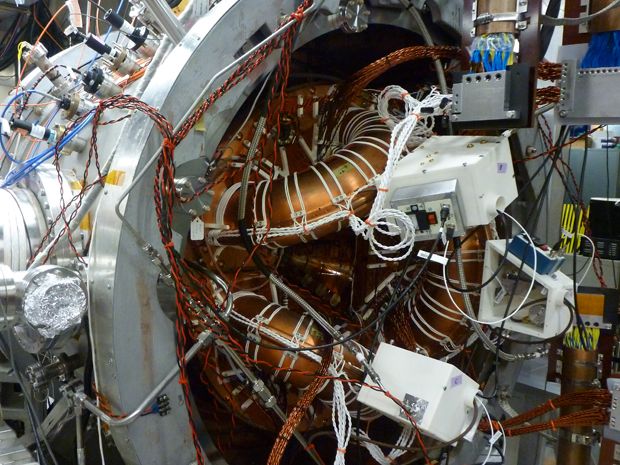Modifying the most common type of experimental reactor might finally make fusion power feasible (from spectrum.ieee.org )
Fusion power has many compelling arguments in its favor. It doesn’t produce dangerous, long-term toxic waste, like nuclear fission. It’s far cleaner than coal, with a supply of fuel that’s virtually unlimited. And unlike with wind and solar, the output of a fusion power plant would be constant and reliable.
In October, Lockheed Martin Corp. revealed that it’s been working on a type of fusion reactor that could be made small enough to transport by truck. Lawrenceville Plasma Physics raised money through crowdfunding in June to advance its alternative proton-boron fusion. Helion Energy is developing a type of fusion based on magnetic compression, and General Fusion is working toward a power system that involves shock waves inside a vortex of liquid metal.
A particularly promising approach was unveiled recently by a University of Washington research group, led by plasma physicist Tom Jarboe. They’ve been developing a type of fusion reactor called a dynomak. The researchers involved say the technology is unique in that it offers a path to a power plant that’s backed up by demonstrated physics and because such a reactor also promises to be even more economical than a coal-fired power plant.The dynomak is a variation of the most popular type of research fusion machine, the tokamak. Essentially, a tokamak is a doughnut-shaped machine that generates helical magnetic fields by combining toroidal fields (which go around the doughnut’s equator) with poloidal fields (which wrap around the outside of the doughnut). These fields have to be strong enough to keep plasma stable and contained indefinitely at the tens to hundreds of millions of degrees Celsius necessary to induce fusion.
In practice, tokamaks are hollow, doughnut-shaped vacuum chambers with interior walls made of heat-resistant metals or ceramics. Outside the chamber are massive superconducting coils that generate the toroidal magnetic fields that stabilize the plasma. The European Union, China, India, Japan, Russia, South Korea, and the United States are collaborating to build a giant US $50 billion tokamak in France called ITER (originally International Thermonuclear Experimental Reactor), which may lead to a fusion power plant in the 2030s. But the University of Washington group—and its alternative-fusion competitors—are hoping to beat it to commercialization.
The University of Washington’s dynomak is a refinement of a subtype of tokamak called a spheromak. The most important difference is that the spheromak does away with most of the tokamak’s expensive superconducting magnetic coils. Instead, a spheromak uses the electric currents flowing though the plasma itself to generate the magnetic fields needed to both stabilize and confine the plasma.
This is tricky, as UW graduate student Derek Sutherland explains. For it to work, you need not only a sophisticated understanding of the physics underlying the behavior of the plasma but also a very efficient way of driving the current. If you’re not careful, you’ll end up dumping all the energy that your reactor is producing right back into the plasma just to keep it contained—resulting in a very expensive machine that will power itself and nothing else.
 According to Sutherland, the big breakthrough was UW’s experimental discovery in 2012 of a physical mechanism called imposed-dynamo current drive (hence “dynomak”). By injecting current directly into the plasma, imposed-dynamo current drive lets the system control the helical fields that keep the plasma confined. The result is that you can reach steady-state fusion in a relatively small and inexpensive reactor. “We are able to drive plasma current more efficiently than previously possible,” says Sutherland. “With that efficiency can come higher current and a more compact, economical design.”
According to Sutherland, the big breakthrough was UW’s experimental discovery in 2012 of a physical mechanism called imposed-dynamo current drive (hence “dynomak”). By injecting current directly into the plasma, imposed-dynamo current drive lets the system control the helical fields that keep the plasma confined. The result is that you can reach steady-state fusion in a relatively small and inexpensive reactor. “We are able to drive plasma current more efficiently than previously possible,” says Sutherland. “With that efficiency can come higher current and a more compact, economical design.”
How economical? According to projections by Sutherland’s group, a dynomak has the potential to cost less than a tenth as much to build as a tokamak like ITER, even as it produces five times as much power. This massive boost in efficiency is very compelling: According to UW’s analysis, it makes the total cost of a dynomak fusion power plant with an output of 1 gigawatt slightly cheaper than the total cost of a coal power plant with the same output—$2.7 billion versus $2.8 billion.
The UW researchers are particularly optimistic about their dynomak because it’s not much of a deviation from established systems. “I think we’ve blended the mainstream and alternates into a pathway that is completely plausible but different enough to really start addressing the economic issues facing fusion power,” says Sutherland.
“The spheromak—and the dynomak is a species of spheromak—in particular has not received the level of attention that it warrants,” says University of Iowa physicist Fred Skiff. “The potential advantages are significant: a lower magnetic field—and therefore lower cost and complexity—and a smaller reactor.” The lower magnetic field requirements are important because “large superconducting coils are not trivial to produce and protect in a reactor environment.”
However, “there are significant unknowns,” says Skiff. “The ability to control the current profile, the plasma position, and the ability to maintain high confinement will have to be demonstrated.”
The next steps for the dynomak are straightforward. The experimental device Jarboe’s group is working with right now, called HIT-SI3, is about one-tenth the size that a commercial dynomak fusion reactor would be. It includes three helicity injectors, which are the coils that control the delivery of twisting magnetic fields into the plasma. “The eventual dynomak reactor will have six injectors according to the current design,” says Sutherland. With $8 million to $10 million in funding, the group hopes to construct HIT-SIX, a six-injector machine that will be twice as large as HIT-SI3.
At that size, things start to get interesting, says Sutherland. HIT-SIX is designed to reach millions of degrees Celsius using a mega-ampere of plasma current. If imposed-dynamo current drive works well in HIT-SIX, he’ll be “much more confident going forward that our development path will be successful,” he says.
That entire path, including an electricity-generating pilot plant, would require about $4 billion, Jarboe’s group projects. Compared with ITER’s $50 billion, that’s a bargain.
